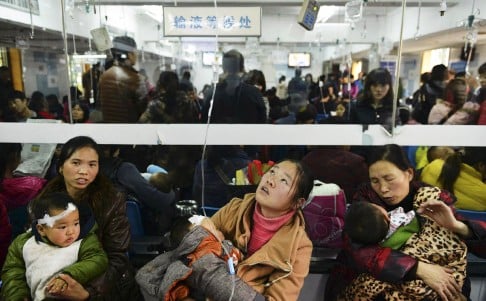South China Morning Post: Smog caused by coal consumption killed an estimated 670,000 people in China in 2012, according to a study by researchers that tries to put a price tag on the environmental and social costs of the heavy reliance on the fuel.
Damage to the environment and health added up to 260 yuan (HK$330) for each tonne produced and used in 2012, said Teng Fei , an associate professor at Tsinghua University.
The 260 yuan is made up of two parts: the health cost and the environmental damage caused by mining and transporting coal.
"With existing environmental fees and taxes of between 30 to 50 yuan for each tonne of coal, the country's current pricing system has largely failed to reflect the true costs," Teng said.
Tiny particulate pollutants, especially those smaller than 2.5 micrograms (known as PM2.5), were linked to 670,000 premature deaths from four diseases - strokes, lung cancer, coronary heart disease and chronic obstructive pulmonary disease - in China in 2012, Teng said.
That translated to an external cost of 166 yuan for each tonne of coal consumed. Authorities levied only about 5 yuan as a pollution fee per tonne of coal used by consumers including power companies and iron, steel and cement producers.
Mining and transport add 94 yuan per tonne, including through damage to groundwater resources, subsidence, deaths and occupational diseases.
Beijing is considering replacing pollution charges with more stringent environmental protection taxes, but progress on legislation has been slow.
Li Guoxing , from Peking University's School of Public Health, said the full impact of coal use was still underestimated as the study did not take into account medical costs associated with other pollution-induced diseases such as asthma.
"The health cost [of the study] is only based on the premature death figures due to the limitations of our research data," said Li. "It could be way higher if we also include medical costs for other chronic illnesses."
The study found that in 2012, more than 70 per cent of the population was exposed to annual PM2.5 pollution levels higher than 35 micrograms per cubic metre, the country's benchmark for healthy air quality.
The World Health Organisation sets its PM2.5 safety limit at an annual concentration of 10mcg/cubic metre. That class of particulate was officially recognised as a human carcinogen last year by the International Agency for Research on Cancer, especially its link to lung cancer and a heightened risk of bladder cancer.
In 2012, some 157 million people in China lived in areas where the annual PM2.5 concentration was higher than 100mcg/cubic metre - 10 times the WHO's recommendation.
A previous study published in British medical journal The Lancet said outdoor air pollution contributed to 1.2 million premature deaths in China in 2010, or 40 per cent of the global total. Former health minister Chen Zhu said this year that pollution caused 350,000 to 500,000 premature deaths a year in China.

